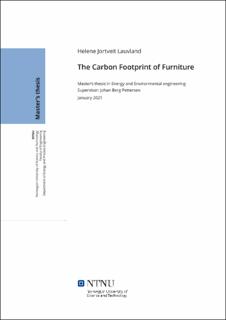| dc.contributor.advisor | Pettersen, Johan Berg | |
| dc.contributor.author | Lauvland, Helene Jortveit | |
| dc.date.accessioned | 2021-09-20T16:55:33Z | |
| dc.date.available | 2021-09-20T16:55:33Z | |
| dc.date.issued | 2021 | |
| dc.identifier | no.ntnu:inspera:67154453:20965782 | |
| dc.identifier.uri | https://hdl.handle.net/11250/2779677 | |
| dc.description.abstract | Bygningsindustrien regnes som et viktig satsingsområde for å reduse globale klimagassutslipp. Møbler er en viktig del av bygninger, men er likevel ikke inkludert i miljøanalyser av bygg eller i strategier for å redusere utslipp i bygningssektoren. For å undersøke hvor stor del av utslipp fra bygninger møbler står for, er karbonavtrykket av møbler i seks ulike bygg funnet. Dette inkluderer to videregående skoler, to universitetsbygg og to kontorbygg. Resultatene viste at møbler bidrar med 4-13\% av totale klimagassutslipp fra bygg. Det er da beregnet for møbler med en levetid på 15 år og 60 års levetid for bygg. Dette er betydelige utslipp, og de bør derfor inkluderes i beregninger for klimagassutslipp fra bygg.
For å redusere karbonavtrykket fra møbler er det lagt til rette for ulike strategier. Strategiene inkluderer økt gjenbruk og oppussing av møbler, lang brukstid med vedlikehold, og materialvalg. Resultatene viser at økt gjenbruk og forlenget levetid er to svært effektive strategier. Å møblere med kun gjenbrukte møbler gav en reduksjon på gjennomsnittlig 59\% sammenlignet med å kjøpe alle møblene nye. Å forlenge brukstiden med 30 år med vedlikehold underveis reduserte utslippene med gjennomsnittlig 46\%. Videre bør møbler med lav miljøpåvirkning implementeres sammen med mer oppussing av møbler og lengre brukstider.
Litteratursøk og samtaler med aktører i møbelbransjen bekrefter at det finnes lite informasjon om miljøpåvirkningen til møbler. Det er ingen retningslinjer bransjen må forholde seg til, i tillegg til at det er få miljøanalyser av møbler tilgjengelig. Dagens systemer støtter ikke strategier som lang brukstid, gjenbruk, vedlikehold og oppussing. Dette begrenser insentiver for å redusere utslipp fra møbler. Klimagassutslipp fra møbler må bli kommunisert og effektive stratefier må bli promotert for å møte denne utfordringen. | |
| dc.description.abstract | The building industry is considered as a key element for mitigating global carbon emissions. Furniture products are an important part of buildings, but are rarely included in environmental analysis of buildings, or mentioned in carbon mitigation strategies for the building sector. To investigate how much furniture contributes to emissions of buildings, the carbon footprint of furniture is found for six non-residential buildings. The case projects include two upper secondary schools, two university buildings and two office buildings. The results showed that furniture contributed to 4-13\% of the total carbon emissions of the building considering a 15 year lifetime of furniture and 60 year lifetime of the building. This is a significant share and should therefore be accounted for as part of building emissions.
To reduce the carbon footprint of furniture, different mitigation through strategies was defined. These included increased reuse and refurbishment, prolonged usage time with maintenance, and material choice. Increasing the amount of reused furniture, as well as ensuring a long usage time for furniture products were found to be two effective measures. By only using reuse, the carbon footprint of the furniture inventory was reduced with an average of 59\% compared to having only new products in the furniture inventory. Prolonging the usage time of the furniture products to 30 years, with additional necessary maintenance processes, reduces the carbon emissions from the furniture inventory by 46\% on average. Additional mitigation strategies found were to ensure more furniture of low environmental impact by right material choices, as well as increased use of refurbishment and longer lifetimes.
Through literature search and conversations with managers and handlers of furniture, it is repeatedly confirmed that there is a lack of information available on the carbon footprint of furniture. Today's practices do not support the effective mitigation strategies of long usage times, reuse, and maintenance and refurbishment processes. There are no policies and few environmental analysis of furniture which reduces the incentive to reduce emission from furniture. The carbon emissions of furniture must be further communicated and mitigation strategies must be promoted to meet this challenge. | |
| dc.language | eng | |
| dc.publisher | NTNU | |
| dc.title | The Carbon Footprint of Furniture | |
| dc.type | Master thesis | |
